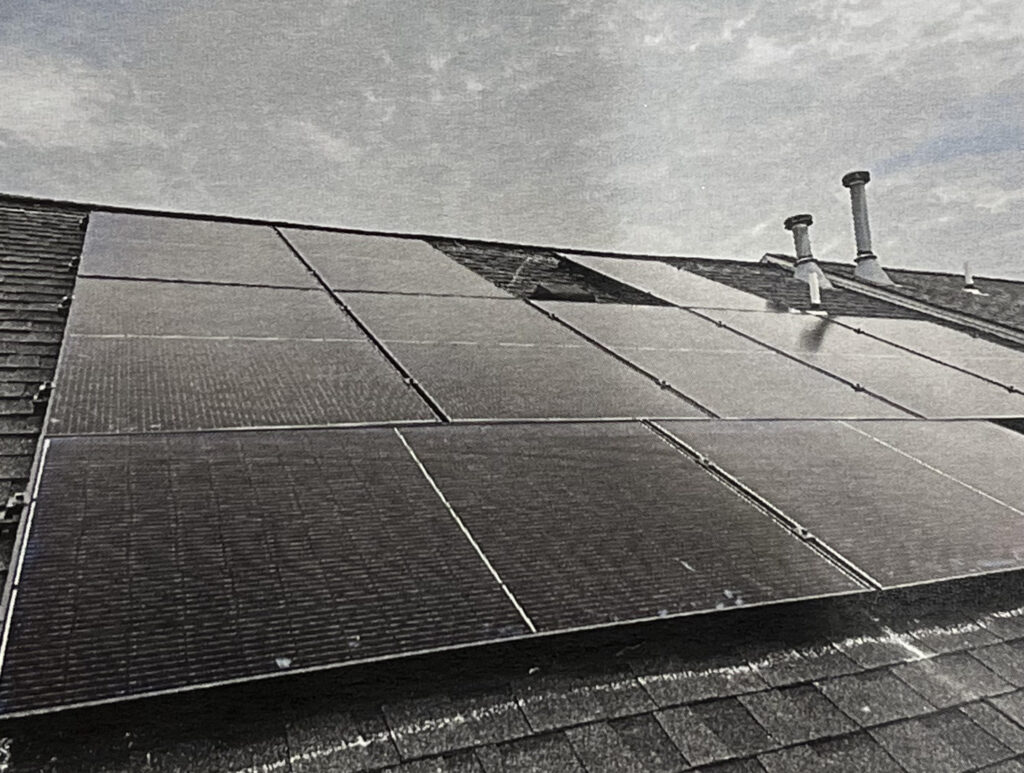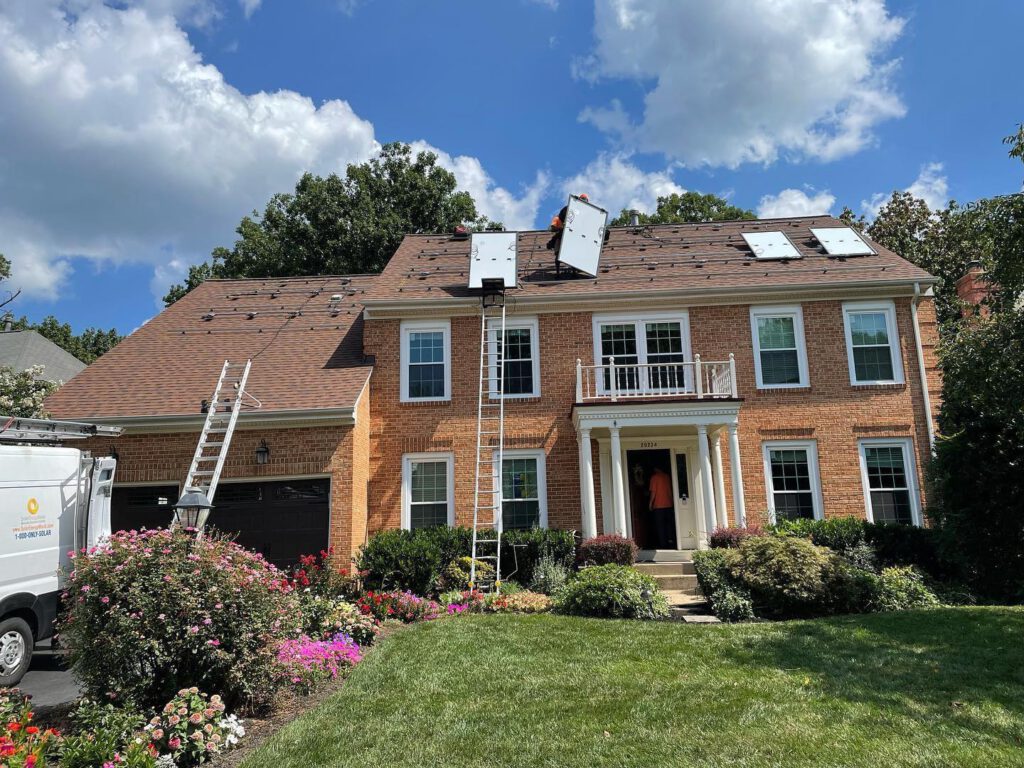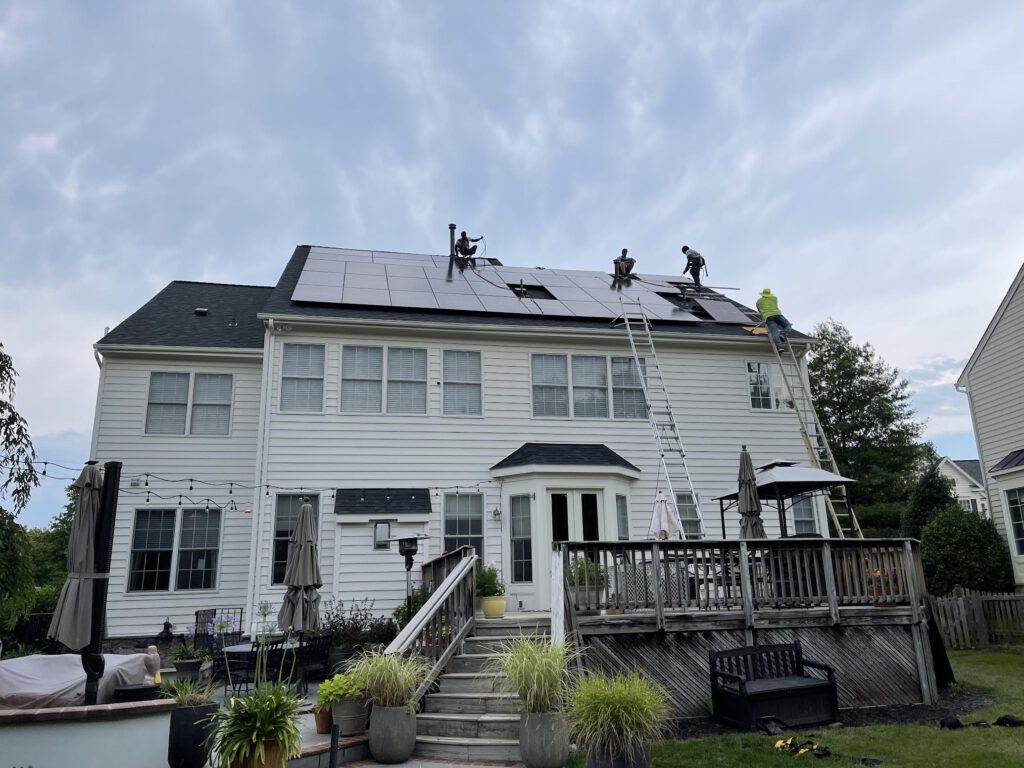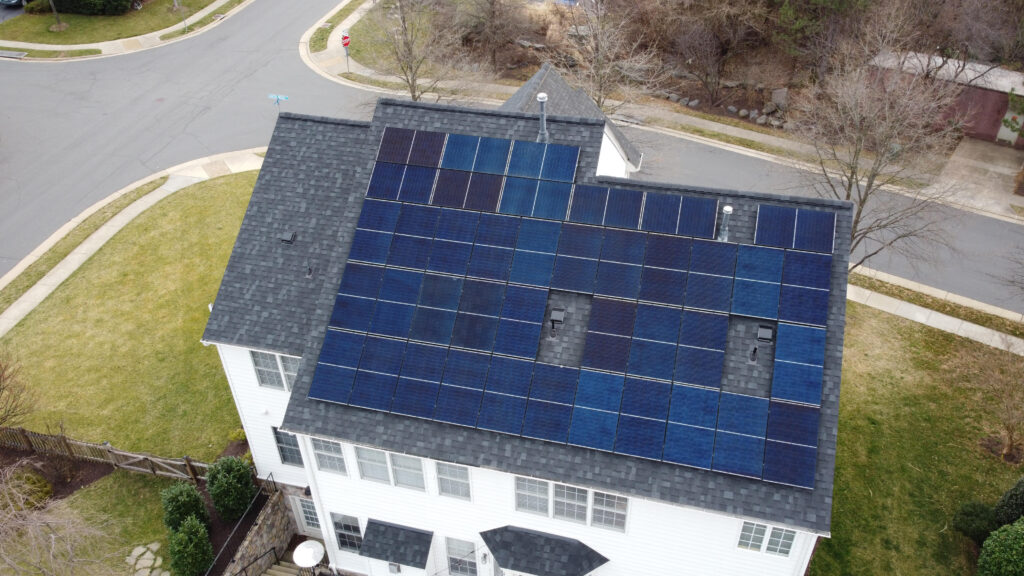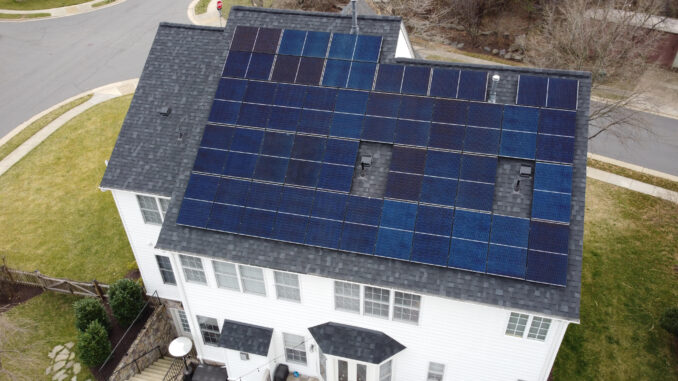
SUNNY WITH A CHANCE OF SAVINGS
By Bill Kent
It was Laura Ellsworth’s idea. While working on her master’s degree in sustainability from Harvard University, the Ashburn Village resident thought it might be a good idea to convert the sunshine that fell on her home into electricity.
Her husband, Patrick, ran the numbers, found an installer and, on a bright morning last August, the couple turned on the solar panels for the first time. They quickly saw the kilowatts they drew from Dominion Energy drop to zero.
What does that mean? It means the panels on their home’s roof were providing enough power to light the lights, air condition every room, run all the appliances, power their technology and gadgets and even recharge their two hybrid automobiles.
“I’m sure we’ll have days when our usage goes higher,” Patrick Ellsworth said. “We’ll go through periods when there’s a thick cloud cover that would reduce what the panels produce, but our electric bill has gone so far down that we’ve had weeks when the [extra] electricity we make … went back into the [local] power grid.”
And if the Ellsworths’ panels generate more power than the couple uses, Dominion will actually pay them for the excess power they send back to the grid. When the couple includes their savings from government solar tax credits and exemptions, they expect the cost of their solar installation will be paid off in seven years – possibly less.
NUMBER CRUNCHING
The Ellsworths are among many Ashburn homeowners who have gone solar in recent years. The Brambleton community alone reports more than 100 solar installations in the past two years.
Among them are Mike and Jessamyn Turicchi, who went solar in November.
“We’ve seen the writing on the wall,” Turicchi said. “Energy prices keep going up, and the solar-generating technology has improved to the point that it’s affordable. Add the tax credits and it’s hard to say no.”
Last August, the U.S. Congress raised the Federal Solar Tax Credit to 30% of the cost of installing a residential solar power system. The cost includes contractor fees, necessary structural repairs or upgrades, permitting and the financing of a loan if needed. Congress also extended the time that a homeowner can take advantage of the credit to 2032.
That means if the full bill for installing a solar power system is $30,000, homeowners can deduct as much as $9,000 from their income tax. The state of Virginia offers benefits for going solar as well.
For the Turicchis, their 40-panel array has cut their electric bill by about 65%. They expect to have the system pay for itself in about 10 years.
“We were hoping for 80%, and we still may get it, but we’re happy with the results,” Mike Turicchi said.
GROWING TREND
Right now, the price range for an Ashburn residential solar power installation is about that of a moderately priced car – from $20,000 to $60,000. That’s according to BrightSuite, a division of Dominion Energy that sells and installs solar equipment in some parts of Virginia.
Timothy and Sharon Giebel came in significantly below that for a 10-panel installation on their Ashburn Village townhome.
“We face south and get sun all the time. When we ran the numbers, it made perfect sense,” Tim Giebel said.
Rick Thrutchley owns RNR Energy Solutions, a Leesburg company that installs solar panels. He said there has definitely been an increased interest in going solar. This is driven in part by the government tax credit, but also by the growth of the electric car market.
“The electric vehicle market and the solar market go hand in hand,” Thrutchley said. “The interest in one generates interest in the other. If you have an electric vehicle and solar, you can eliminate two bills – your gas bill and your power bill.”
The trend isn’t strictly residential. Brambleton plans to add solar panels this year to a new maintenance building. Last year Ashburn Farm put up solar panels on its Windmill Drive community center and Breezy Hill recreation building. At the Windmill Drive center, nearly every section of the building’s roof is covered with large, dark photovoltaic rectangles. Installed in two phases from May through September, the system is expected to save the community at least $15,000 a year.
FACTORS TO CONSIDER
While the advantages of solar power can be appealing, it is not for everyone. In some locations, tall trees and nearby structures can put a home in shade for most of the day.
Among other factors to consider are the direction a house’s roof faces. South is best; east or west are good; north may be problematic. Then there’s the size and kind of roof. The more panels that can fit on a roof, the more electricity they can generate. A broad, gable-type roof free of dormers, skylights and utility vents is ideal.
And there’s the condition of a roof. Adding solar panels will complicate any repairs a roof may require. Some roofing materials will support the added weight of the panels better than others. So, a new roof may be necessary before the panels go up.
Finally, there is the cost. Most of the roughly half-dozen solar installers currently working in Ashburn will help homeowners qualify for a loan to pay for the panels, the permitting, any physical upgrades to their roof and the added technology their home will need to manage the system.
With federal, state and local tax credits, as well as a reduction in electric bills, the cost for the upgrade should be at or below what a homeowner currently pays for electricity so that the system will pay for itself in seven to 10 years.
WORDS OF CAUTION
Unfortunately, not everyone will qualify to go solar at their home, even if they really want to. RNR Energy’s Thrutchley says solar companies follow a formula of sorts to determine whether a potential client will benefit. In many cases, perhaps the majority, solar isn’t right for the homeowner. The factors mentioned above can actually mean going solar will cost more rather than less.
“There are a lot of people who can’t go solar,” he said. “The numbers don’t lie. There has to be a clear path to savings.”
Ashburn Realtor Bob Caines is not a solar enthusiast when it comes to his line of work. To Caines, residential solar power is like a swimming pool.
“If you really want a house with a pool, and you see a house that has one, you may go for that house, even if it isn’t exactly the kind of pool you may like, because it’s easier and cheaper to have the pool in place than to go through the cost and trouble of having a new one put in,” he said.
Among most of the buyers looking in Ashburn that Caine has met, solar panels are not a major factor in a home-buying decision.
“I can see how it would be for a person who would advocate for the environment,” Caine said. “But if you ask me if a solar installation would increase the value of an Ashburn home right now, I’d have to say no.”
GOING FOR IT
Nevertheless – for a multitude of reasons – solar panels continue to pop up around Ashburn.
The Giebels found the installer they wanted when a sales representative knocked on their door. Meanwhile, the Ellsworths took a more methodical approach. They spent nearly a year interviewing five installers they found online, as well as speaking with neighbors who had gone solar.
“You have a lot of things to think about, and a lot of things you can learn before settling on an installer,” Patrick Ellsworth advised. “Some of it is asking the questions you would have for any contractor doing a major renovation on your house.”
For the Ellsworths, the Giebels and the Turicchis – and their fellow Ashburn homeowners who qualified for solar and have taken the plunge – the future looks sunny indeed.
Bill Kent is a prolific writer and author whose articles have appeared in The New York Times, the Philadelphia Inquirer, Kirkus Reviews and elsewhere.

